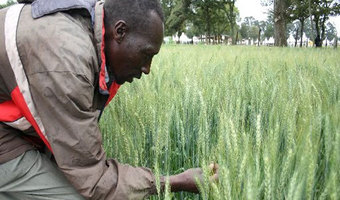 Kimani Warutara is all smiles as he admires the towering lush of his wheat farm. In the last three harvests he managed to get half of what his two acre piece originally produced, thanks to swathes of grassy weeds that he has been unable to control.
Kimani Warutara is all smiles as he admires the towering lush of his wheat farm. In the last three harvests he managed to get half of what his two acre piece originally produced, thanks to swathes of grassy weeds that he has been unable to control.
Warutara has been broadcasting wheat seeds over the seasons but has been challenged by weed problems which has affected yields as the weeds compete for nutrients with the weed. “I have spent so much time and money recruiting casual labourers. But the weeds have been so invasive and reproduce so fast that by the time we are done weeding they have re emerged,” said Warutara.
A farmer group in Narok area where Warutara farms, has been his saving grace as farmers learn how planting in rows reduces the spread of the weed. In the last two seasons, he has recorded a doubling of yields as he plants the wheat crop in rows, leaving about 30 centimetres between each row. The beauty with this method is that it is easier to spot and separate the grassy weeds from the wheat since the rows are conspicuous. I now no longer need my casual labourers the work is not involving so I rely on my family for weeding. I have really cut cost,” said Warutara.
Aware of the benefits of row planting in a country whose smallholder farmers have traditionally used broadcast method, the government and the private sector are partnering to promote row planting as an easier way of managing weeds. The increased yields from reducing competition for nutrients they say would go along way in reducing food insecurity in the country.
“The trouble with the grassy weed is that it resembles wheat. It has become such a terrible venture for farmers because those that I have dealt with have lost upto half of their yields to the weeds. The row planting technique has been a game changer because weeds always crop up between the rows and therefore farmers can easily spot them,” said Jamleck Kiptoo a crop scientist who has been promoting row planting.
According to Kiptoo, when cereal seeds are broadcast, weedy grasses rob the crops of sunlight, water, and nutrients. “In row planting, where fertilizer and seeds are mixed together and planted in rows, the grassy weeds lack fertilizer, and as a result they become thin and almost disappear,’’ he added.
Warutara who spends most of the time tracking the progress on the wheat farm is optimistic of a bumper harvest. “ I am noticing a very big difference compared to the previous harvests. The farm looks so clean and the wheat crop healthy. This is a sign of good things to come,” added Warutara.
















Comments powered by CComment